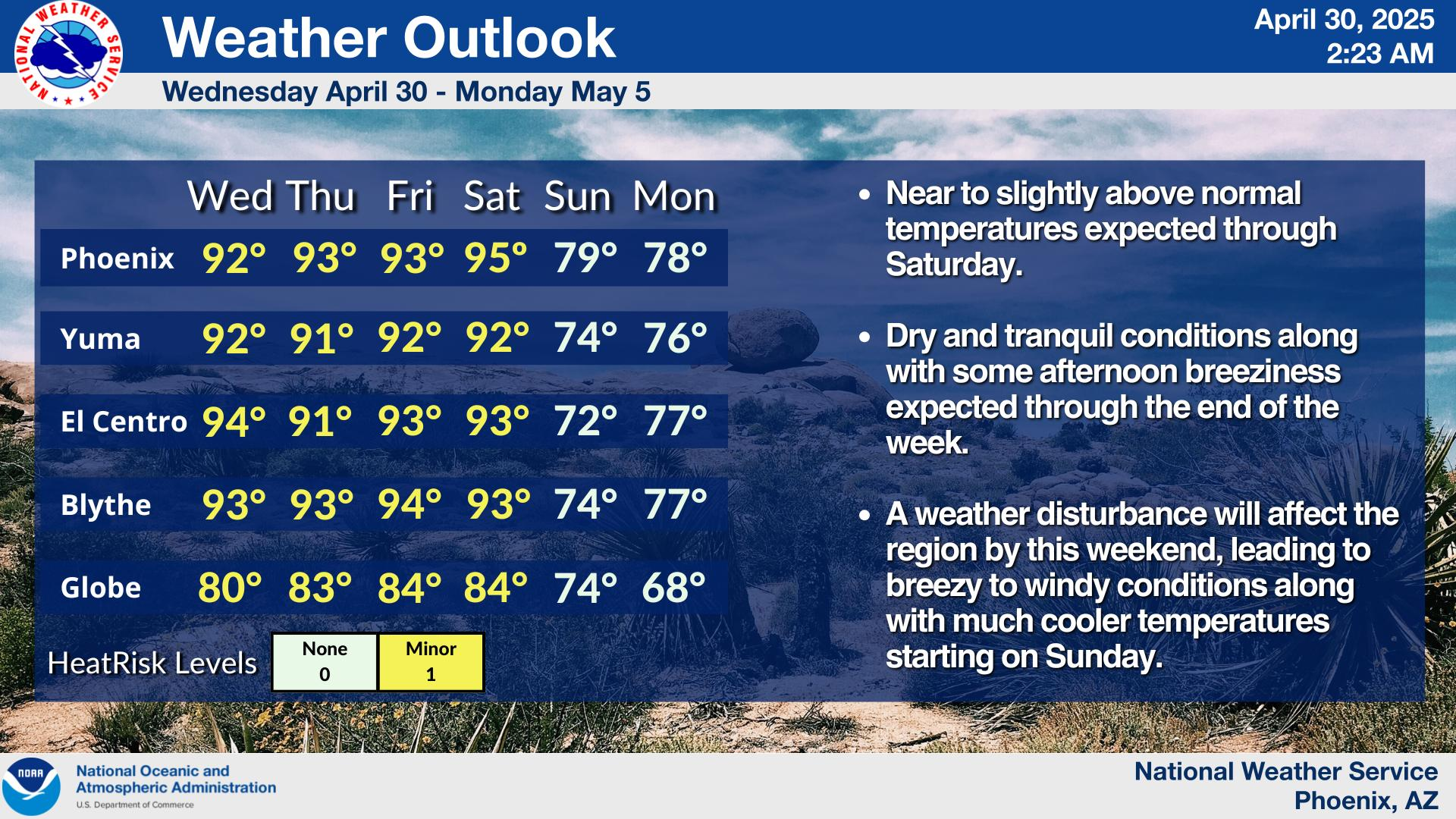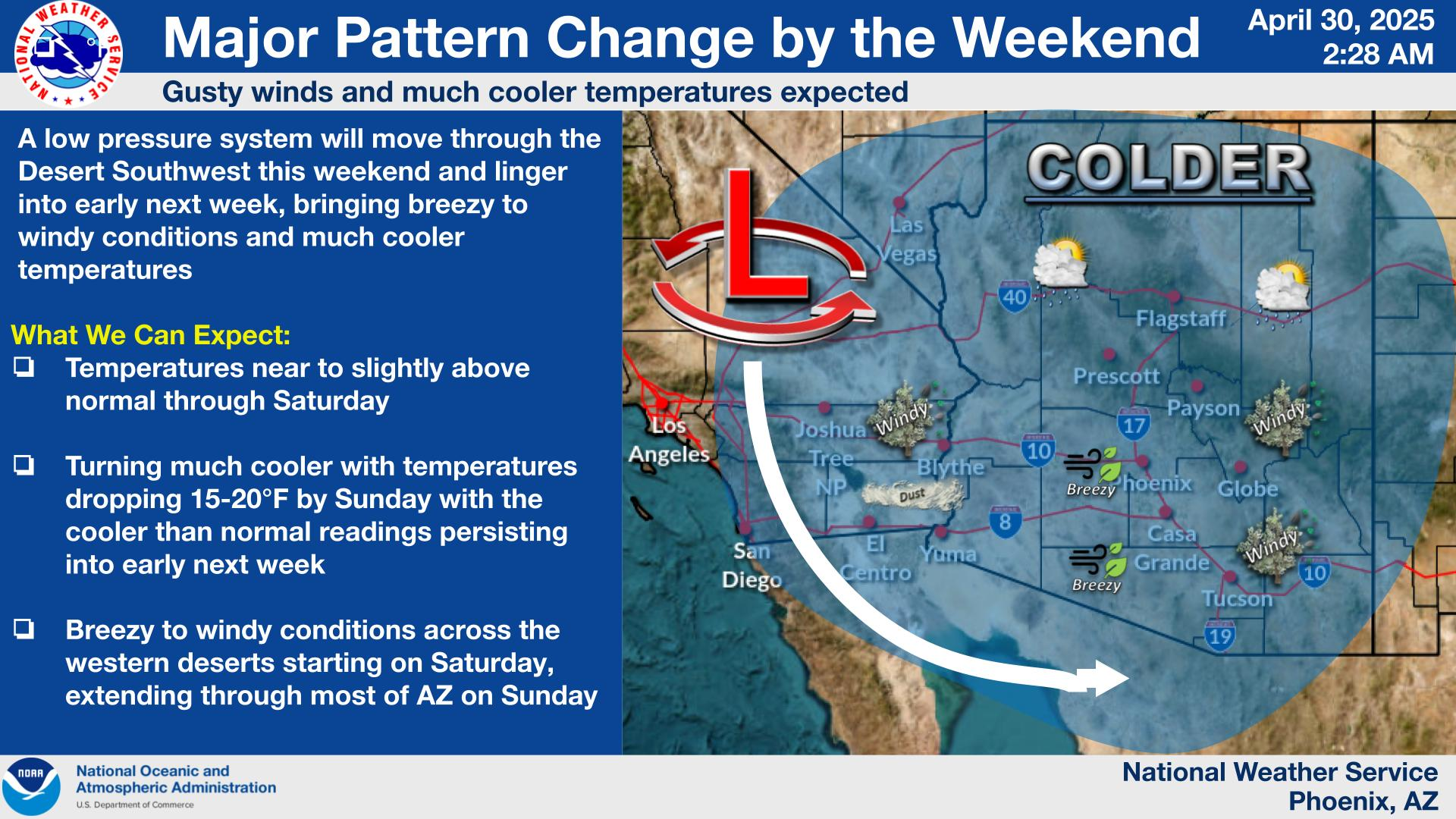
775
FXUS65 KPSR 132314
AFDPSR
Area Forecast Discussion
National Weather Service Phoenix AZ
414 PM MST Sat Dec 13 2025
.UPDATE...Updated 00Z Aviation Discussion.
&&
.KEY MESSAGES...
- Well above normal temperatures will prevail across the entire
region through next week.
- Record setting highs and warm lows will be possible across the
lower deserts including Phoenix on Sunday and Monday.
- Dry and tranquil weather will continue for the next several days.
&&
.SHORT TERM /TODAY THROUGH MONDAY/...
An unseasonably strong ridge of high pressure continues to be the
dominate the weather feature over the Desert Southwest. This ridge
has brought several days of abnormally warm temperatures and
benign weather conditions to our area. The 500 mb ridge will reach
peak strength on Sunday before a weak shortwave trough replaces
the ridge on Monday. 500 mb hghts will rise up to 580-583 dam
across the forecast area on Sunday, resulting in sfc highs
reaching the upper 70s to lower 80s across the lower deserts.
Record warm lows/highs will be threatened Sunday morning/afternoon.
For Phoenix Sky Harbor, the latest NBM probabilities of at least
tying the record warm low Sunday morning is around 60% and the
probability of tying or reaching a new record high is up to 90-95%
Sunday afternoon. Although temperatures will cool by a degree or
two on Monday due to the arrival of the shortwave trough, highs
are still expected to reach near daily records around 80 degrees
in locations including Phoenix, Yuma, and El Centro.
&&
.LONG TERM /TUESDAY THROUGH NEXT FRIDAY/...
Very little will change as far as the weather pattern is expected
for next week with the large scale ridging remaining the dominant
feature. The very weak disturbance currently off the southern
California coast will eventually cut through the ridge later
Monday and Monday night, likely knocking temperatures down a
degree or two for Tuesday and possibly Wednesday. However, the
ridge will quickly rebuild to our west and is forecast to shift
back into our region by Wednesday. We should maintain H5 heights
of 580-584dm over our region through the rest of next week with
dry westerly flow persisting under clear to mostly clear skies.
Depending on the strength of the ridge later next week, we may
again see highs topping 80 degrees in some spots later next week
into next weekend. Long range guidance is still pointing toward a
potential pattern shift by around Christmas which may bring a
larger trough farther to the south along the West Coast. If this
occurs, it could bring an end to our unseasonably warm and dry
conditions.
&&
.AVIATION...Updated at 2311Z.
South Central Arizona including KPHX, KIWA, KSDL, and KDVT; and
Southeast California/Southwest Arizona including KIPL and KBLH:
No aviation weather concerns will exist through the TAF period.
Light winds (generally AOB 10 kts) will follow a familiar diurnal
pattern, with extended periods of variability to nearly calm
conditions, especially during diurnal transitions, followed
by a slight increase in wind speeds into tomorrow morning. FEW-SCT
high clouds will continue to persist.
&&
.FIRE WEATHER...
A strong ridge of high pressure will continue to encompass the
region, resulting in warm and dry conditions persisting well into
next week. High temperatures in the upper 70s to the lower 80s
will be common across the lower deserts, or around 10 to 15
degrees above daily normals. Winds will follow typical diurnal
trends with occasional afternoon and overnight breeziness across
the AZ high terrain. Daily MinRHs will range between 15-25% while
overnight recoveries run generally between 40-70%.
&&
.CLIMATE...Daily Record Highs
Phoenix
-------
12/13 82 (2010)
12/14 78 (2010)
12/15 79 (1969)
&&
.PSR WATCHES/WARNINGS/ADVISORIES...
AZ...None.
CA...None.
&&
$$
SHORT TERM...Salerno
LONG TERM...Kuhlman
AVIATION...Ryan/Berislavich
FIRE WEATHER...Kuhlman/Salerno
CLIMATE...Benedict
NWS Phoenix Office






